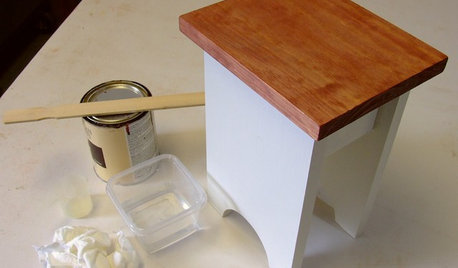blotchy water based stain
davisgard
16 years ago
Related Stories

DIY PROJECTSCool Tip: Mimic Stain With a DIY Color Wash
Get the look of an oil-based stain without all the bother, using this easy wash made with paint
Full Story
HOUSEKEEPINGDon't Touch Another Stain Before You Read This
Even an innocent swipe with water may cause permanent damage. Here's what to know about how rugs and fabrics react
Full Story
HOUSEKEEPINGOut, Darn Spot! Tips for Removing Carpet Stains
Know the right solutions and when to use them to prevent stains from pets, soda, chocolate, blood and more
Full Story
HOUSEKEEPINGHow to Clean Grout — Stains and All
If your grout is grossing you out, this deep-cleaning method will help it look new again
Full Story
KITCHEN CABINETSKitchen Cabinet Color: Should You Paint or Stain?
Learn about durability, looks, cost and more for wooden cabinet finishes to make the right choice for your kitchen
Full Story
LANDSCAPE DESIGNHow to Make Your Painted or Stained House Feel at Home in the Landscape
Use color and texture to create a pleasing connection between your house and garden
Full Story
HOUSEKEEPINGHow to Remove Water Rings From Wood Tables
You may be surprised by some of these ideas for removing cloudy white water marks from wood surfaces
Full Story
ARCHITECTUREWant to Live by the Water? What You Need to Know
Waterside homes can have amazing charm, but you'll have to weather design restrictions, codes and surveys
Full Story
LIFEThe Top 5 Ways to Save Water at Home
Get on the fast track to preserving a valuable resource and saving money too with these smart, effective strategies
Full Story
KITCHEN DESIGNKitchen Counters: Durable, Easy-Clean Soapstone
Give bacteria the boot and say sayonara to stains with this long-lasting material that's a great choice for kitchen and bath countertops
Full StoryMore Discussions










Stocky
davisgardOriginal Author
Related Professionals
Crestview Cabinets & Cabinetry · North New Hyde Park Cabinets & Cabinetry · North Bay Shore Cabinets & Cabinetry · Bellwood Cabinets & Cabinetry · Enumclaw Carpenters · Ballwin Flooring Contractors · Cartersville Flooring Contractors · East Grand Rapids Flooring Contractors · East Palo Alto Flooring Contractors · Medford Furniture & Accessories · Roswell Furniture & Accessories · Woodbury Furniture & Accessories · Glenvar Heights Furniture & Accessories · La Mirada Furniture & Accessories · Northridge Furniture & AccessoriesUser
kmealy
bobcat138_att_net
brickeyee